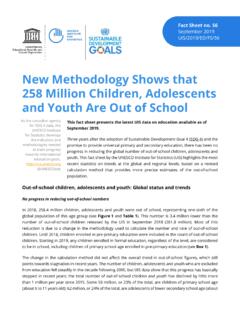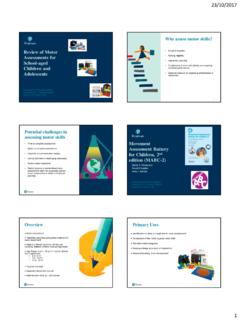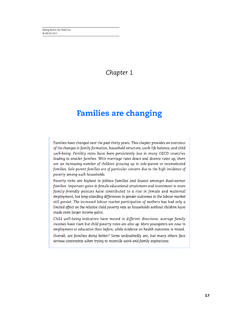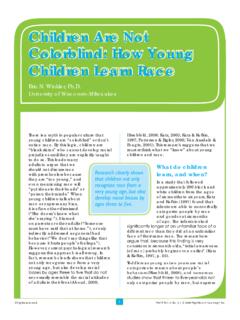Transcription of Estimated Prevalence of Children With Diagnosed ...
1 NCHS Data Brief No. 291 November DEPARTMENT OF HEALTH AND HUMAN SERVICESC enters for Disease Control and PreventionNational Center for Health StatisticsEstimated Prevalence of Children With Diagnosed Developmental Disabilities in the United States, 2014 2016 Benjamin Zablotsky, , Lindsey I. Black, , and Stephen J. Blumberg, findings Data from the National Health Interview Survey During 2014 2016, theprevalence of childrenaged 3 17 years who hadever been Diagnosed witha developmental disabilityincreased from During this same time,the Prevalence of diagnosedautism spectrum disorder andintellectual disability did notchange significantly. The Prevalence of autismspectrum disorder, intellectualdisability, other developmentaldelay, and any developmentaldisability was higher amongboys compared with girls.
2 The Prevalence of anydevelopmental disability waslower among Hispanic childrencompared with Children in allother race and ethnicity disabilities are a set of heterogeneous disorders characterized by difficulties in one or more domains, including but not limited to, learning, behavior, and self-care. This report provides the latest Prevalence estimates for Diagnosed autism spectrum disorder, intellectual disability, and other developmental delay among Children aged 3 17 years from the 2014 2016 National Health Interview Survey (NHIS). Estimates are also presented for any developmental disability, defined as having had one or more of these three diagnoses. Prevalence estimates are based on parent or guardian report of ever receiving a diagnosis of each developmental disability from a doctor or other health care : autism spectrum disorder National Health Interview SurveyThe Prevalence of Children Diagnosed with any developmental disability increased from 2014 to 1.
3 Prevalence of Children aged 3 17 years ever Diagnosed with selected developmental disabilites, by year: United States, 2014 2016201420152016 Autism spectrum disorderDevelopmental disability1 Other developmental delay1 Intellectual increase from 2014 to 2016 is statistically significant (p < ).NOTES: Developmental disability includes autism spectrum disorder, intellectual disability, and any other developmental delay. Access data table for Figure 1 at: # : NCHS, National Health Interview Survey, 2014 Data Brief No. 291 November 2017 2 During 2014 2016, the Prevalence of Children ever Diagnosed with any developmentaldisability significantly increased, from in 2014 to in 2016 (Figure 1).
4 The Prevalence of Children ever Diagnosed with a developmental delay other than autismspectrum disorder or intellectual disability increased, from in 2014 to in 2016. There was not a statistically significant change in the Prevalence of Children ever diagnosedwith autism spectrum disorder from 2014 to 2016. The Prevalence of Children ever Diagnosed with intellectual disability did not significantlychange from 2014 to higher percentage of boys have been Diagnosed with autism spectrum disorder compared with girls. During 2014 2016, the Prevalence of Children Diagnosed with autism spectrum disorder washigher among boys ( ) than girls ( ) (Figure 2). Non-Hispanic white Children ( ) were more likely to have been Diagnosed with autismspectrum disorder than Hispanic Children ( ).
5 Children aged 8 12 years ( ) were more likely to have been Diagnosed with autismspectrum disorder than Children aged 3 7 years ( ).Figure 2. Prevalence of Children aged 3 17 years ever Diagnosed with autism spectrum disorder, by sex, age, and race and ethnicity: United States, 2014 2016 Percent01234 Non-Hispanic and ethnicityNon-Hispanic group (years)1 Significantly different from girls (p < ).2 Significantly different from Children aged 3 7 years (p < ).3 Significantly different from Hispanic Children (p < ).NOTE: Access data table for Figure 2 at: # : NCHS, National Health Interview Survey, 2014 Data Brief No. 291 November 2017 3 The difference in the Prevalence of Children Diagnosed with autism spectrum disorder between the ages of 8 12 ( ) and 13 17 ( ) years was not statistically significant (p = ).
6 The Prevalence of Diagnosed intellectual disability was higher among boys than girls. During 2014 2016, the Prevalence of Children ever Diagnosed with intellectual disability was among boys and among girls (Figure 3). The Prevalence of intellectual disability was lower among younger Children than older Children : among Children aged 3 7 years, among Children aged 8 12 years, and among Children aged 13 17 years. The Prevalence of Children Diagnosed with intellectual disability did not differ significantly by race and Hispanic ethnicity. The difference in the Prevalence of intellectual disability between non-Hispanic black Children ( ) and non-Hispanic other Children ( ) was not statistically significant (p = ).
7 Figure 3. Prevalence of Children aged 3 17 years ever Diagnosed with intellectual disability, by sex, age, and race and ethnicity: United States, 2014 2016 Age group (years) and ethnicityNon-Hispanic 71 Significantly different from girls (p < ).2 Significantly different from Children aged 3 7 years (p < ).NOTE: Access data table for Figure 3 at: # : NCHS, National Health Interview Survey, 2014 Data Brief No. 291 November 2017 4 The Prevalence of Children ever Diagnosed with developmental delay other than autism spectrum disorder or intellectual disability was lowest among older Children . The Prevalence of other developmental delay was higher among boys ( ) than girls ( ) (Figure 4).
8 During 2014 2016, Children aged 3 7 ( ) and 8 12 ( ) years had a higher Prevalence of other developmental delay compared with Children aged 13 17 years ( ). Non-Hispanic white Children ( ) had a higher Prevalence of other developmental delay compared with Hispanic Children ( ).Figure 4. Prevalence of Children aged 3 17 years ever Diagnosed with other developmental delay, by sex, age, and race and ethnicity: United States, 2014 7 Age group (years) whiteRace and different from girls (p < ).2 Significantly different from Children aged 13 17 years (p < ).3 Significantly different from Hispanic Children (p < ).NOTE: Access data table for Figure 4 at: # : NCHS, National Health Interview Survey, 2014 Data Brief No.
9 291 November 2017 5 The Prevalence of developmental disabilities was lowest among Hispanic Children . The Prevalence of developmental disabilities was higher among boys ( ) than girls ( ) (Figure 5). Children aged 13 17 years ( ) were less likely to have been Diagnosed with any developmental disability than Children aged 8 12 years ( ). During 2014 2016, Hispanic Children ( ) were less likely to have been Diagnosed with any developmental disability compared with non-Hispanic white Children ( ), non-Hispanic black Children ( ), and non-Hispanic other Children ( ).Figure 5. Prevalence of Children aged 3 17 years ever Diagnosed with any developmental disability, by sex, age, and race and ethnicity: United States, 2014 20160123456789 PercentTo 7 Age group (years) whiteRace and different from girls (p < ).
10 2 Significantly different from Children aged 8 12 years (p < ).3 Significantly different from Hispanic Children (p < ).NOTE: Access data table for Figure 5 at: # : NCHS, National Health Interview Survey, 2014 Data Brief No. 291 November 2017 6 SummaryDuring 2014 2016, there was a significant increase in the Prevalence of Children who had ever been Diagnosed with any developmental disability. This increase was largely the result of an increase in the Prevalence of Children Diagnosed with a developmental delay other than autism spectrum disorder or intellectual disability. There was not a significant change in the Prevalence of Diagnosed autism spectrum disorder or intellectual disability over the same time Prevalence of developmental disabilities described in this report is lower than findings described in previous reports using NHIS data (1).


















